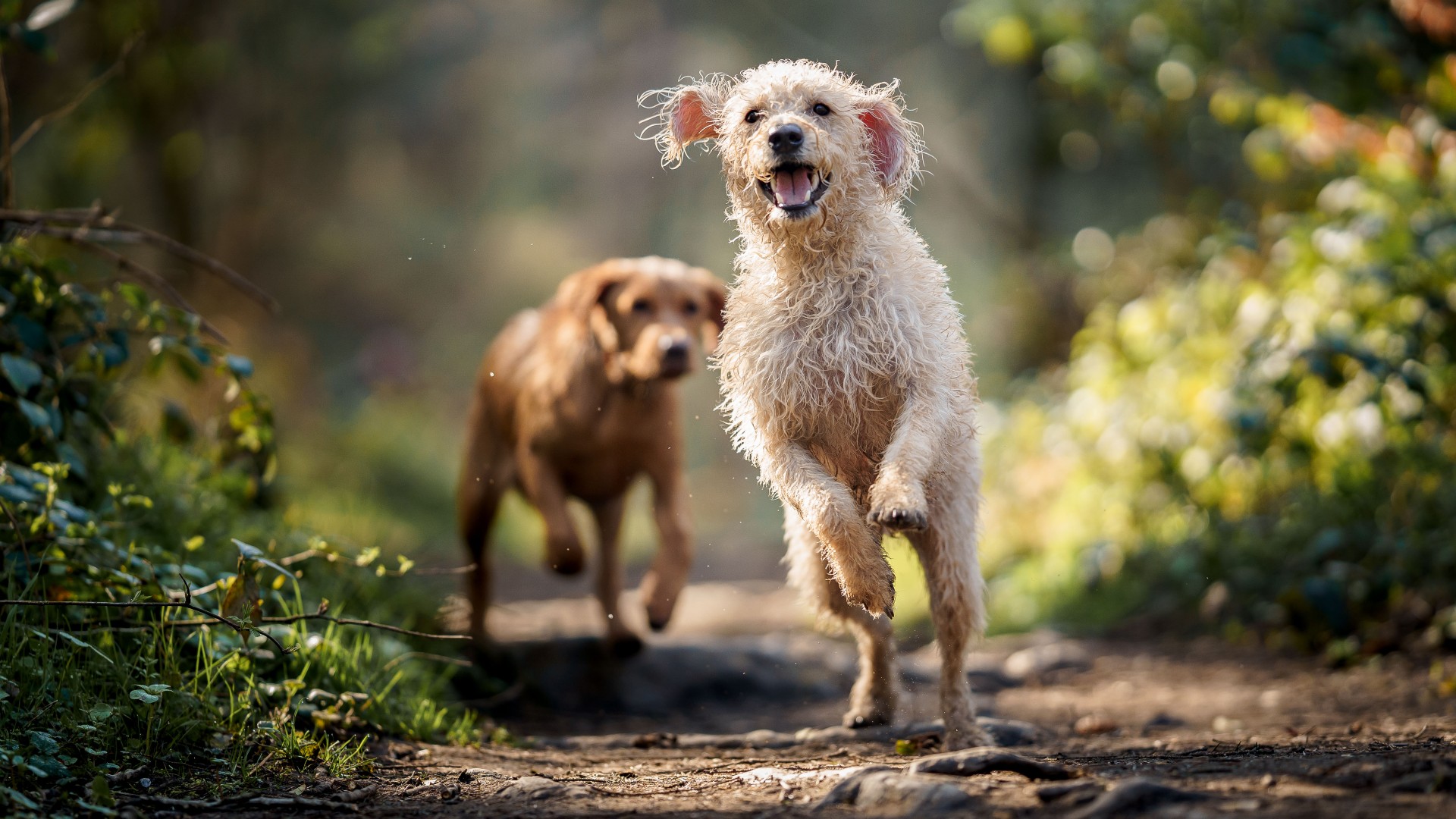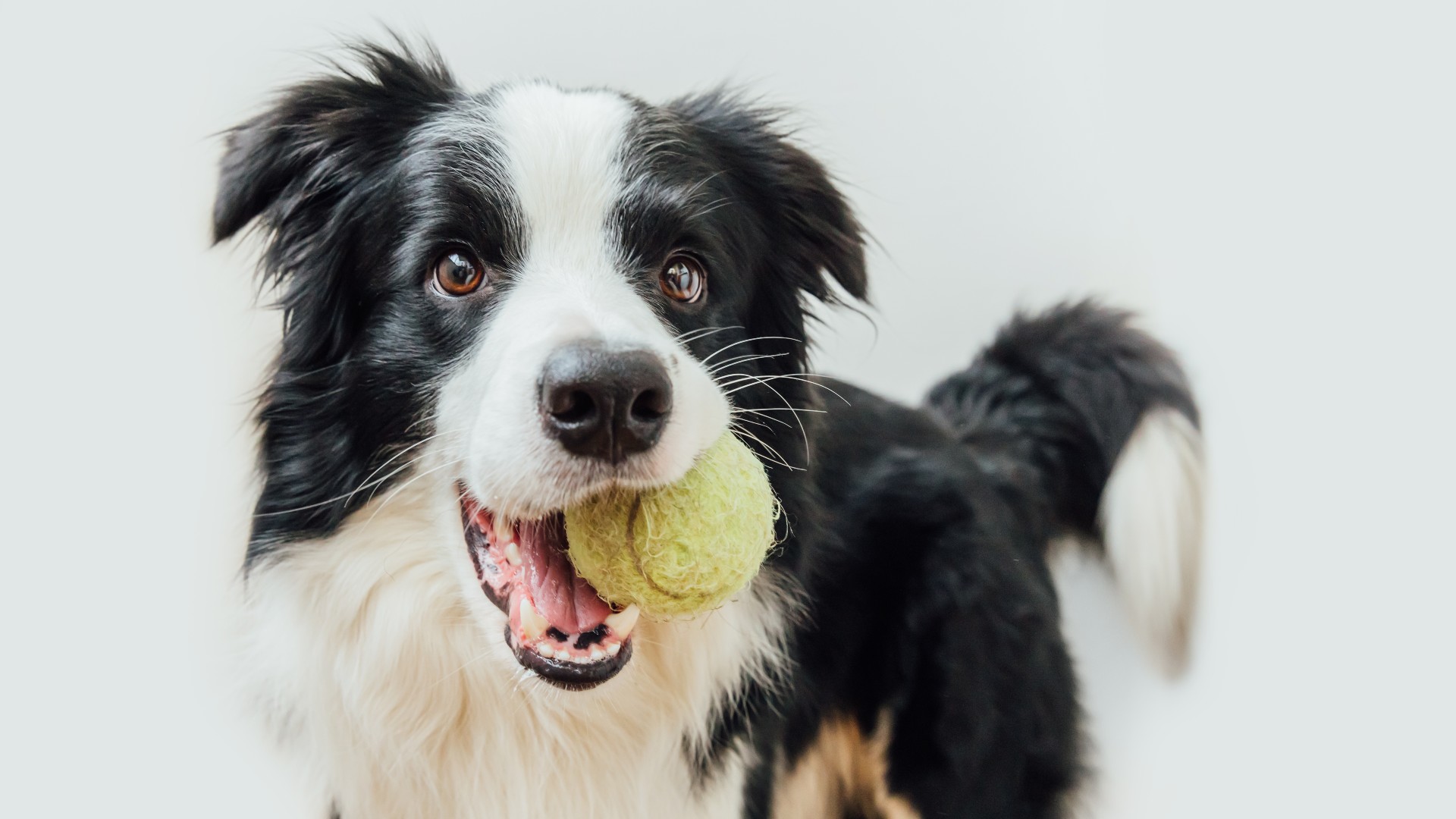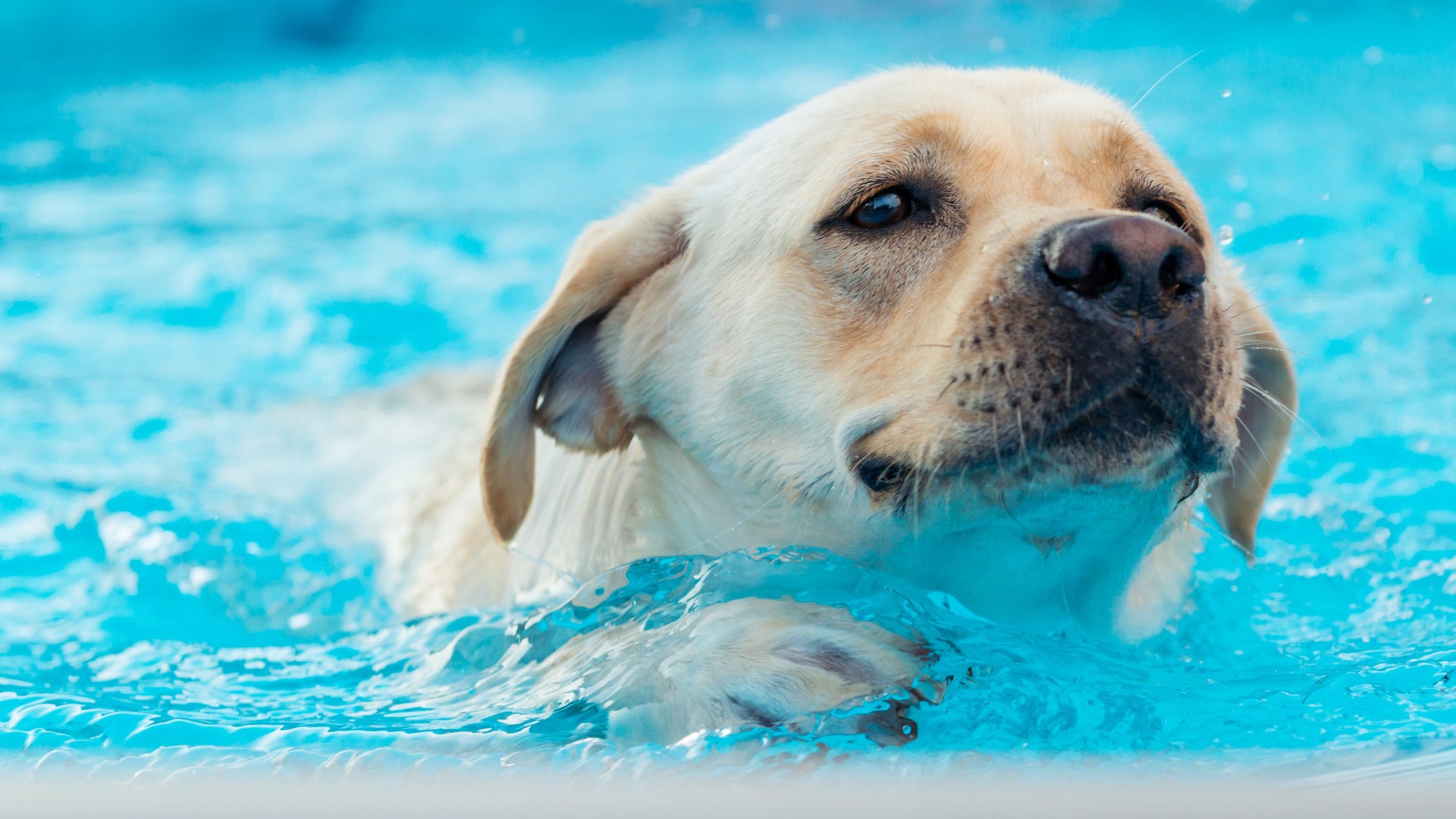How much exercise do dogs need?
From age and stage to breed and energy level, we answer the question 'how much exercise do dogs need?' and reveal the signs your pup isn't getting enough

How much exercise do dogs need? If you’re the proud pet parent to a canine companion, you’ve likely found yourself asking that question on more than one occasion. While you’d think it would be as straightforward as investing in one of the best dog leashes and hitting the pavement, the answer is a little more complex than it first appears.
Your dog’s age, breed and whether or not they’re in good health will all influence how much exercise they need, so there isn’t a one-size-fits-all approach when it comes to getting out and about in the great outdoors.
High-energy dog breeds are going to need a lot more physical activity than their couch-potato counterparts and puppies will need to have their exercise staggered in a different way to an adult dog.
Every breed though, regardless of their age and stage, needs some form of activity each day to keep them happy and healthy and one of the easiest ways to do this is to take them out for a daily walk. And speaking of going walkies, check out our dog walking etiquette tips before you head out to ensure you have a stress-free stroll.
Below, you’ll find everything you need to know to help you figure out how much exercise your dog needs, including information for each age and activity level. We’ve also included some great tips for ways that you can get more exercise into your dog’s day and if you’re wanting more advice, you’ll find our vet’s guide to dog exercise super helpful.
How much exercise do dogs need?
When it comes to how much exercise your dog needs, it’s important to consider your canine companion’s age and breed as both of these will serve as a useful guide to helping you to ensure they get the right amount of activity each day. Let's take a look...
Puppies
When it comes to physical activity, the general consensus for puppies is to factor in short bursts of exercise throughout the day - and for good reason. There’s a lot of debate about how much exercise puppies need, but most vets and trainers are in agreement that too much exercise can be hard on your puppy’s developing body.
Because puppies have more energy than most adult dogs, you’ll find that alongside your scheduled sessions of physical activity, they’ll likely spontaneously burst into several bouts of the zoomies throughout the day as a way of burning some of this energy off.
We recommend that in the first six months of your puppy’s life, you stick to short walks of around 15-20 minutes twice a day and mix that up with short play sessions at home with plenty of time for naps so that you little one can recover.
As your puppy gets older, you’ll be able to slowly increase the length of the walk and if your vet agrees, you may even be able to factor in some short jogs. Make sure you take some breaks while you’re out and about and monitor your puppy to ensure they’re coping ok with the increase in exercise.
It’s also worth considering your puppy’s breed to help you figure out how much exercise they’ll be able to do. Border Collies and Australian Shepherds are going to have a higher exercise tolerance than a Pug, for example, while German Shepherds and Belgian Malinois’ will love having some brain games thrown into their day to give their mind a good workout.
Adult dogs

When it comes to an adult dog, it’s crucial you consider their breed and use that to guide you when it comes to figuring out how much exercise they need. As a general rule of thumb, healthy adult dogs need a minimum of 30 minutes of exercise per day, but you’ll find most do best with 60 minutes.
Now, the most important thing to remember is that some dogs will not be able to do an hour of exercise in one burst, so you may want to split those walks into two shorter sessions to ensure you don’t over-tax them. Once again, their breed will determine how their daily activity needs to be structured.
For example, flat-faced breeds, like the Pug and French Bulldog, may struggle to walk for an hour. That’s because they have breathing difficulties that lower their exercise tolerance. This is particularly true in the warmer months, where the heat can make even 15 minutes of activity difficult for them to cope with.
Then there’s the best small dog breeds and toy dog breeds, which, as you’d expect, can’t handle as much exercise as their bigger buddies. That doesn’t mean they don’t love being active though, on the contrary, many of these dog’s have lots of energy and love to play, but you’ll want to make sure you split their walks up so they’re doing several small ones each day.
When it comes to the best large dog breeds, don’t assume that just because they’re giant in size that they’re going to be suitable for going out running with you every day. In fact, the bigger the breed, the more likely they are to suffer from joint and hip issues. When it comes to dogs like the Great Dane, a low-impact exercise like swimming can be great, as can brief hikes and fetch sessions.
Finally, there’s the high-energy dog breeds and these pups are ideal for active pet parents who really want to engage in vigorous activity each day. Sporting breeds, (think the working Cocker Spaniel and the Golden Retriever), herding breeds (like the Australian Cattle Dog and the Pembroke Welsh Corgi), and working breeds (such as the Bernese Mountain Dog and the Rottweiler) do best with a good 90 minutes of strenuous exercise to burn off the bucket loads of energy that they have.
Senior dogs
If you have a senior dog who struggles with mobility issues, it’s vital that you still give them the physical and mental stimulation they need each day to ensure they stay fit on all fronts. Yes, you will need to make some moderations to their routine, but exercise is still going to be an important part of their day.
The easiest way to get in their required 30 minutes of exercise is to take them on 2-3 short walks around the block. You’ll likely notice they tire easily and will probably plod along fairly slowly, but these little walks are necessary for their mental and physical wellbeing.
Choose a form of exercise that they’re able to manage without too much discomfort - running is definitely a no-no if they have arthritis or suffer from joint pain as it’s too high-impact, but a gentle walk or some time in the pool or ocean are both wonderful choices.
If you find your senior pooch really struggles with their daily exercise routine, physical therapy can be a great way of providing their joints and muscles with some relief. You could opt for a water-based form of therapy or go with massage therapy, both are brilliant for helping to ease discomfort and make exercising a more comfortable and pleasurable experience.
Signs your dog needs more exercise

If you’re worried that you may not be giving your dog enough exercise each day but you’re not sure how to know for sure, these signs will help you figure out whether or not you’re on the right track.
1. Weight gain
One of the biggest signs that your dog isn’t getting enough exercise is if they’ve started to gain weight. If you’re still feeding them their usual portion of the best dog food and they’re looking a little chubbier than they have done in the past, upping their activity levels and seeing if that makes a difference is always our first recommend port of call if you're wondering what to do if your dog is overweight.
While taking in more energy than they’re expending is a guaranteed way to pack on the pounds, there are certain medical conditions that can cause obesity as well. If your dog’s weight has changed suddenly, make sure you speak with your vet who will be able to rule out any underlying health problems.
2. Destructive behavior
Wondering how to stop your dog chewing on the carpet? Or perhaps your pup has suddenly started pulling things out of the trash can at every opportunity? Dogs need an outlet for their energy and a bored dog will tend to be a troublesome dog. If you notice that your dog has started behaving destructively, upping their exercise may solve the problem.
3. Excessive barking
There’s nothing worse than having to listen to your dog barking constantly throughout the day, and while there could be a multitude of reasons for this unwanted and unwelcome behavior, if you have a dog that won't stop barking, it could be a sign of boredom.
Because our furry friends can’t use words to communicate how they’re feeling or what it is they’re needing, they may resort to incessant barking as a way of letting you know that they’re not getting the physical activity their body needs.
4. Being depressed
While it’s easy to think that exercise is necessary purely for your dog’s physical health, just like us humans, our canine companions also need exercise for their mental wellbeing and not getting enough can cause them to get serious case of dog depression.
If you notice that your dog seems more withdrawn than usual, is sluggish or listless for much of the day or spends a lot of time sitting in the corner on their own and not wanting to engage, it could be that they’re feeling depressed. There are other potential reasons for this sort of behavior though, so do get your dog checked out by their vet if boosting their daily activity doesn’t resolve the problem.
5. Restlessness
Is your dog having trouble sleeping at night? Do they struggle to sit still during the day? Do they pace back and forth a lot? All of these are signs that your dog has energy to burn, so if you spot these, make sure you take them for a good walk to tire them out.
How to provide more exercise

When it comes to exercise, there are the obvious forms, such as walking or running, that we pet parents are well aware of. But, for those days when heading outside just isn’t doable or you’re looking for a new form of activity, here’s some great ways that you can provide your pup with more physical and mental stimulation:
1. Play hide and seek
One of our favorite indoor games for dogs, hide and seek is a great way to burn off some of your canine companion’s energy and, as a bonus, you’re bound to enjoy it too! If you’re looking for a fun activity that will exercise your dog’s brain and body, this one is at the top of our list.
To play this game, show your dog a toy, shut them in another room while you hide it and then let them out and ask them to retrieve it for you using the command ‘find it’. If your dog isn’t good with commands yet, use one of the best dog treats instead of a toy as they’ll be able to use their nose to sniff it out.
2. Invest in a puzzle toy
The best dog puzzle toys are a really fun way to give your pup’s mind a good mental workout and all that hidden food provides them with a great incentive to solve it. Puzzle toys are great for all breeds, but they’re particularly wonderful for highly intelligent dogs, like the Doberman Pinscher and the Poodle, who love a good challenge.
3. Hire a dog walker
There’s been a huge uptake in the amount of people learning how to become a dog walker, so if you find you’re a bit stretched for time each day and you have the financial resources to be able to afford it, hiring a dog walker can be a real lifesaver! Most dog walkers offer a variety of different services, so you can choose the length of walk that best suits your dog - and your wallet.
4. Doggie daycare
Another great option for busy pet parents is doggie daycare, which high energy breeds in particular love. After all, if you have lots of energy to burn, what could be better than spending a day playing with a whole bunch of new furry friends? If you have a dog who’s highly social and is great at responding to commands, doggie daycare is well worth considering.
5. Hit the water
Swimming is a wonderful activity for all dogs, but particularly our senior canine companions or those that suffer from joint pain or mobility issues. If you have access to a pool or there’s a body of water nearby, swimming provides a wonderfully intensive but seriously low-impact workout that your pup is sure to enjoy.
Are you questioning, ‘how far can a puppy walk?’ This feature reveals the answer.
PetsRadar Newsletter
Get the best advice, tips and top tech for your beloved Pets

Kathryn is a freelance writer who has been a member of the PetsRadar family since it launched in 2020. Highly experienced in her field, she's driven by a desire to provide pet parents with accurate, timely, and informative content that enables them to provide their fur friends with everything they need to thrive. Kathryn works closely with vets and trainers to ensure all articles offer the most up-to-date information across a range of pet-related fields, from insights into health and behavior issues to tips on products and training. When she’s not busy crafting the perfect sentence for her features, buying guides and news pieces, she can be found hanging out with her family (which includes one super sassy cat), drinking copious amounts of Jasmine tea and reading all the books.
